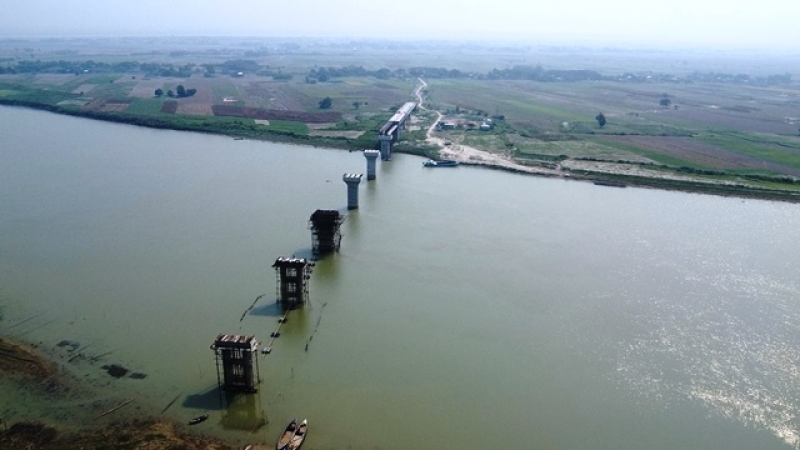- CA Yunus pays homage to Liberation War martyrs on Victory Day |
- Bangladesh capital market extends losing streak for second day |
- Bangladesh celebrates Victory Day Tuesday |
- 'Different govts presented history based on their own ideologies': JU VC |
7 years on, Faridpur Bridge remains a broken promise

The under construction Faridpur Bridge remains a broken dream for long seven years. UNB
Faridpur, June 14 - On the tranquil banks of a sleepy branch of the mighty Padma River, dreams once stirred with the first blows of construction.
A 580-metre bridge, envisioned to link Faridpur’s bustling district town with the isolated char areas beyond the waters, now stands as a monument to delay, disillusionment and desertion.
Seven long years have drifted by like the currents below, yet the bridge remains unfinished—its promise trapped in rusting rods and skeletal girders.
For the thousands who live in the char lands, life is an endless wait, punctuated by engine boat rides and the hope that each passing season might bring a new dawn.
The bridge, part of the "Polli Soroke Guruttopurno Setu Nirman" initiative, stretches across the Bhajandanga Ghat–Gendumolla Haat GC Road in Sadar upazila.
Originally designed as a 550-metre PSC girder bridge and later extended to 580 metres, its grand beginning in 2018 came with an ambitious budget of around Tk 76 crore and lofty aspirations of transforming rural isolation into connected prosperity.
But dreams are delicate things.
By 2020, the bridge was dealt a grievous blow. The original contractor, Rafia Construction, vanished from the site, leaving only the echo of halted machinery.
Its proprietors, Rubel and Barkat, became entangled in a sprawling Tk 2,000 crore money laundering scandal, their flight from justice mirrored by the project’s stalling into silence.
It was not until 2022 that life returned to the construction site with the arrival of Faridpur Jannat Construction Ltd and The Nirmito.
Yet the rekindling has been feeble. Now, after six years of broken schedules and shifting targets, only 55 to 60 per cent of the work is reportedly complete, with fresh estimates placing full completion a distant two years away.
Local hearts have grown weary.
“We’ve been watching this bridge construction drag on for years,” sighed Hafiz Matubbar, a resident who lives on the river’s edge.
“The only way across is by engine boats or trawlers, which is a daily hardship for around 50,000 people,” he said.
His voice, heavy with frustration, finds echoes in the words of Idris Bepari, Abzal Hossain, and Miraj Hossain, who speak of the anguish faced by students missing school, patients stranded far from medical care, and farmers cut off from markets.
"There is no permanent road here,” said Murad Hossain from Digreechar union, adding, “During the monsoon, when currents grow fierce, even the trawlers stop. We’re left marooned.”
The bridge, meant to be a symbol of upliftment, now casts a shadow. “It’s dangerous to travel, especially in bad weather,” Murad added.
“Reaching a hospital or sending kids to school becomes nearly impossible. We had dreams when the bridge work started. Now, it feels like a nightmare," he said.
Fingers point in every direction—from negligent contractors to lethargic oversight. Locals speak in hushed tones of corruption, red tape, and shifting contractors as reasons behind the exasperating crawl of progress.
Their patience, once robust, has thinned with each extension and unfulfilled deadline.
“Finishing this bridge is not just important, it’s urgent,” declared Mehedi Hasan Mintu, chairman of the local Union Parishad. “Our farmers are suffering huge losses, unable to transport their produce to the town markets. The economy of this area is bleeding.”
When approached, Abu Hanif, site manager for Jannat Construction, acknowledged the slow pace, attributing it to seasonal challenges.
“The rainy season will make it difficult to speed up the work. The remaining tasks will take at least another two years to complete,” he admitted.
Debashish Bakchi, LGED engineer for Faridpur Sadar, confirmed that the contractor’s official term ends this June. “Around 60 per cent of the work is done, but with rising river water levels, finishing on time will be very difficult,” he said, with his tone betraying little hope.
Beyond bricks and cement, this bridge carries the weight of human longing—for access to education, healthcare, livelihood. Each steel span is meant to connect lives, not just lands.
Yet for now, the people of the char remain stranded, caught in a tide of bureaucratic inertia and unmet promises.
Where hope once shimmered in concrete plans, despair now lingers like mist over the Padma’s waters. - UNB

